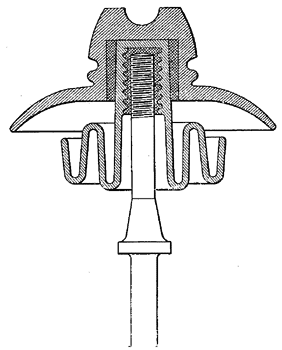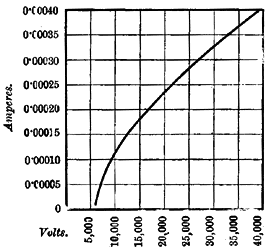[Trade Journal]
Publication: The Electrician
London, England
p. 632, col. 1
INSULATORS FOR HIGH PRESSURES.
Fig. 1 shows the section of a porcelain insulator designed for very high tensions and put on the market by Messrs. E. IL Cadiot & Co. These insulators, called "Cloche Mehun," were tested by the Lalnratoire Central d'Electricite with the results given below. The voltage employed for testing was 750 volts, the electrification being kept up during five minutes. Of the resistances of the 17 insulators tested none was inferior to 1,500,000 megohms, whereas the mean resistance was found to be 25,000,000 megohms. In a second test alternating current of a frequency of 42 cycles per second was employed, the voltage being gradually increased from 8,000 to 41,000 volts.
 |
| Fig. 1. - Section Through "Cloche Mehun" Insulator. Scale 3 in. = 1 Ft. |
The temperature of the test room was the same as in the first test — i.e., 15 deg C., and the hygrometer showed 67 deg. One insulator broke through at a voltage of 41,000 volts. In a third series of tests the current leakage was determined for various voltages. The mean results are given in the curve (Fig. 2). The temperature of the testing room was 16.5 deg C., and the hygrometer was 64 deg. In a fourth test the insulators were plunged into acidulated water. The room temperature was 15 deg C., and the hygrometer stood at 64 deg. Alternating current of the same frequency as before was employed. One insulator only is said to have broken down at a voltage of 40,500 volts.
 |
| Fig. 2. - Loss of Current at Various Voltages. |
